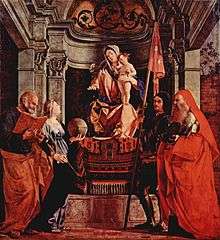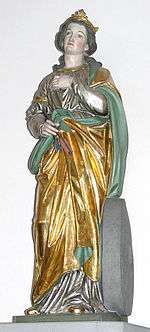Christina of Bolsena
| Saint Christina of Bolsena a.k.a. Saint Christina of Tyre | |
|---|---|
|
St Christina, by Moriz Schlachter, (c.1889) | |
| Virgin and Martyr | |
| Born |
3rd Century Persia (modern-day Iran and Iraq) or Tyre, Lebanon |
| Died |
3rd Century Bolsena, Lazio, Italy |
| Venerated in | Eastern Orthodox Church, Roman Catholic Church |
| Canonized | Pre-Congregation |
| Major shrine | Toffia, Italy; Palermo, Sicily, Italy |
| Feast | July 24 |
Saint Christina of Bolsena, also known as Christina of Tyre, or in the Eastern Orthodox Church as Christina the Great Martyr,[1] is venerated as a Christian martyr of the 3rd century. Archaeological excavations of an underground cemetery constructed at her tomb have shown that she was venerated at Bolsena by the fourth century.
Life
The existence of Christina herself is poorly attested. Some versions of her legend place her in Tyre (Phoenicia), other evidence points to Bolsena, an ancient town in central Italy, near an Etruscan site called Volsinium, with catacombs in which archeologists have found the remains of an early Christian church and the tomb of a female martyr. Inscriptions found on the site confirm that this martyr had a name like Christina and that the local community was venerating her as a saint by the end of the fourth century. Some corroborating evidence is provided by a sixth-century mosaic in the basilica of St. Apollinare Nuovo at Ravenna, which includes in its procession of virgins a saint named Christina, wearing a martyr's crown.[2]
Legend of Saint Christina
Christina is an early virgin martyr with a legend too fanciful to have much historical credibility.[2] Nothing is now known about her life. But by the ninth century, an account of her martyrdom was composed, which developed many variants. According to these, she was born either in Tyre (Eastern stories) or in Persia (Western stories) during the 3rd century or 5th century.
She was born into a rich family, and her father was governor of Tyre. By the age of 11 the girl was exceptionally beautiful, and many wanted to marry her. Christina's father, however, envisioned that his daughter should become a pagan priestess. To this end he placed her in a special dwelling where he had set up many gold and silver idols, and he commanded his daughter to burn incense before them. Two servants attended Christina.[3]
According to accounts, one time Christina was visited by an angel, who instructed her in the true faith. The angel called her a bride of Christ and told her about her future suffering. Christina smashed all the idols in her room and threw them out the window. In visiting his daughter, Christina's father, Urbanus, asked her where all the idols had disappeared. Christina was silent. Then, having summoned the servants, Urbanus learned the truth from them.[3]

Urbanus had his daughter tortured because of her faith, but God thwarted his efforts on several occasions. The nature of the torture varies with each telling, and can include iron hooks, grilling by fire, placement in a furnace, torture on the wheel, assault by snakes, assailment by arrows, and other assorted methods which she survives. After her father's death, his successor, Dion, continued to torture her. Christina is eventually beheaded.[4]
Some scholars have concluded that her legend is the result of pious fiction being mistaken for history. The theme of her legend (a beautiful Christian maiden is tortured to death by pagan men, who in return suffer the wrath of God) is repeated in many ancient and medieval hagiographies, particularly that of Saint Barbara.
Catholic Church
The entry for her in the 2004 Roman Martyrology is very brief: "At Bolsena in Tuscany, Saint Christina, Virgin and Martyr". She was once included in the General Roman Calendar. The Tridentine Calendar gave her a commemoration within the Mass of the Vigil of Saint James. When in 1955 Pope Pius XII suppressed this vigil,[5] the celebration of Saint Christina became a "simple" and in 1960 a "commemoration".[6] The 1969 revision omitted her from that calendar, "because nothing is known of this virgin and martyr apart from her name and her burial at Bolsena",[7] but not from the Martyrology, the official list of recognized saints. According to the present rules in the Roman Missal, Saint Christina may be celebrated with a "memorial" everywhere on her feast day, unless in some locality an obligatory celebration is assigned to that day.[8]
Relics
Toffia in the Province of Rieti displays her relics in a transparent urn. Palermo, of which Christina is one of four patron saints, also claims to hold her relics.
The Eastern tradition that connects Saint Christina with Tyre, Lebanon may be due to confusion with the name of a locality near Bolsena.
The Cathedral of St. John the Evangelist in Cleveland, Ohio claims "In the Resurrection Chapel, below the altar, is the reliquary of St. Christine, including her entire skeleton and small vial of her blood. The relics were presented to Archbishop Schrembs in 1928 by Pope Pius XI. Tradition says that Christina was a girl of 13 or 14 who died for her faith around 300 A.D."[9]
Miracle of Bolsena
A second legend is connected to St Christina. The Eucharistic miracle, depicted in Raphael's The Mass at Bolsena, is often considered to be the catalyst for the Feast of Corpus Christi, recalls an event in the Umbrian region of Italy in 1263. A priest named Peter from the city of Prague nurtured doubts regarding the transubstantiation of the Host during Mass, and during his pilgrimage toward Rome prayed to be relieved of his questions. While saying the words of consecration in the Basilica of Santa Cristina at Bolsena, the Host dripped blood on his hands and on the cloth below.[10]
References
- ↑ Αποστολική Διακονία (Greek)
- 1 2 Reames, Sherry L. ed., "Christina of Bolsena: Introduction", Middle English Legends of Women Saints, Kalamazoo, Michigan: Medieval Institute Publications, 2003
- 1 2 "Saint Christina of Tyre (July 24)". Official website of the Antiochian Orthodox Christian Archdiocese of Australia, New Zealand and the Philippines. Retrieved September 27, 2015.
- ↑ "St. Christina of Tyre, Martyr", Orthodox Church in America
- ↑ General Roman Calendar of Pope Pius XII
- ↑ General Roman Calendar of 1960
- ↑ "Calendarium Romanum" (Libreria Editrice Vaticana, 1969), p. 131
- ↑ General Instruction of the Roman Missal Archived July 20, 2008, at the Wayback Machine., 355 c
- ↑ Bulletin of The Cathedral of Saint John the Evangelist, July 25, 2010
- ↑ "Poetry, painting and procession", Zenit, June 23, 2011
 This article incorporates text from a publication now in the public domain: Herbermann, Charles, ed. (1913). "article name needed". Catholic Encyclopedia. New York: Robert Appleton.
This article incorporates text from a publication now in the public domain: Herbermann, Charles, ed. (1913). "article name needed". Catholic Encyclopedia. New York: Robert Appleton.
External links
- Passio di Santa Cristina (Italian)
- Archidiocesis de Madrid: Santa Cristina (Spanish)
- Catholic Online-Saints & Angels: St Christina
- "Martyr Christina of Tyre". The Orthodox Church in America.

